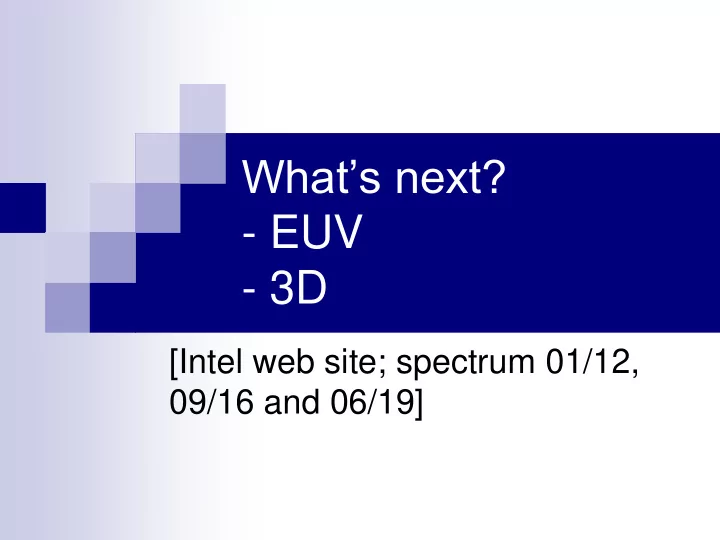

What’s next? - EUV - 3D [Intel web site; spectrum 01/12, 09/16 and 06/19]
Problems of EUV lithography [Spectrum, Aug 07] No powerful enough (~200 W) light sources available, and no sensitive enough (~ 5mJ/cm 2 ) photoresist available -> no way, at the moment, to have ~ 100 wafers per hour (acceptable commercial throughput) Deployment is expected around 2018-2020
Transistors could stop shrinking in 2021 [Spectrum, Sept 16] After more than 50 years of miniaturization, the transistor could stop shrinking in just five years. That is the prediction of the 2015 International Technology Roadmap for Semiconductors (ITRS)
Transistors could stop shrinking in 2021 [Spectrum, Sept 16] After 2021, the report forecasts, it will no longer be economically desirable for companies to continue traditional transistor miniaturization in microprocessors. Instead, chip manufacturers will turn to other means of boosting density, namely turning the transistor geometry from horizontal to vertical and building multiple layers of circuitry, one on top of another replacing traditional silicon channels by channels made with alternative materials, namely silicon germanium, germanium, and III-V compounds
The 5 nm node [Spectrum, June 2019] Taiwan Semiconductor Manufacturing Co. (TSMC) and Samsung: 5 nanometer manufacturing process is now in what’s called “risk production” the company believes it has finished the process, but initial customers are taking a chance that it will work for their designs the 5 nm node is the first to be built from the start using EUV ( l =13.5 nm) the foundries are thought to be using 10 to 12 EUV steps Please note: these are improvements
The 5 nm node [Spectrum, June 2019] Photomasks that contain the patterns are very expensive and each lithography machine itself is a US $100 million – plus investment both companies identified some likely early adopters, including suppliers that make smartphone application processors and 5G infrastructure: high volume and a need for either speed or power efficiency GlobalFoundries gave up at 14 nm and Intel is years late with its rollout of an equivalent to competitors’ 7 nm next step should be 3 nm, but foundries are expected to offer a variety of technologies with incremental improvements that fill in the gaps indeed, both Samsung and TSMC are offering what they’re calling a 6 nm process
Recommend
More recommend